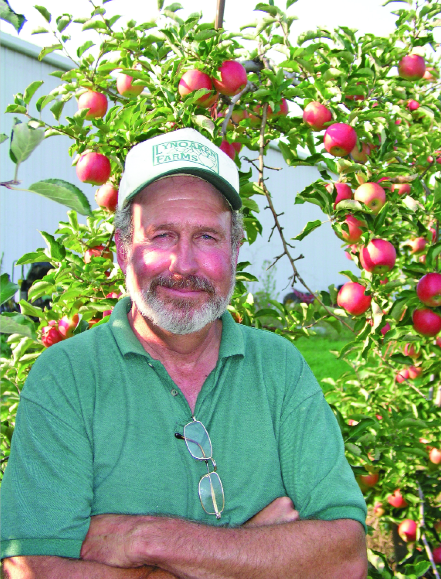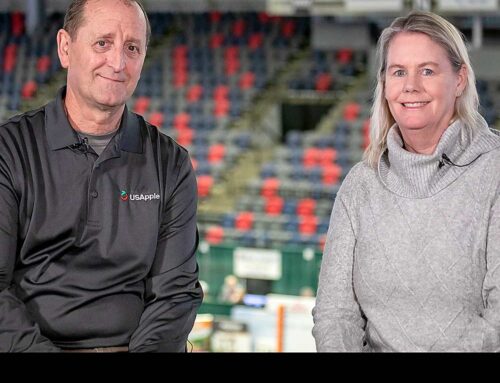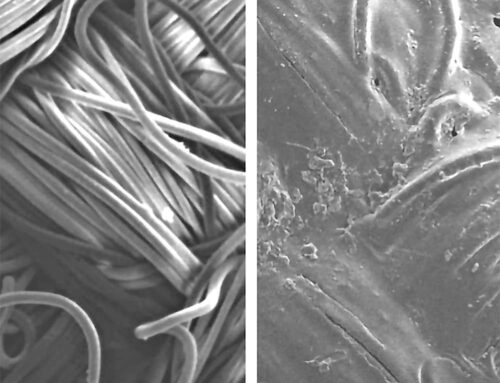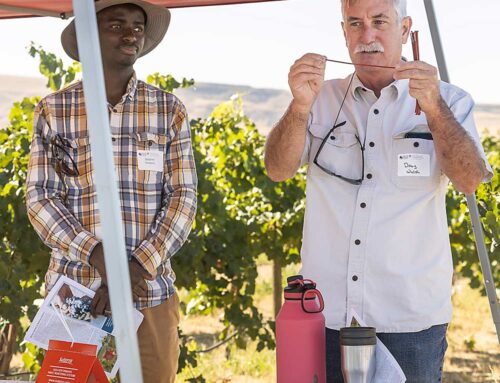
Darrel Oakes of Lyndonville, New York, believes adoption of orchard technology is directly related to tree size and design. Photo by Melissa Hansen
As the tree fruit industry searches for ways to reduce production costs, tree design will play a major role in how fast new technology is adopted. Innovative grower Darrel Oakes of Lyndonville, New York, caught the attention of many in the mid-1990s with his over-the-row sprayer for apples.
The sprayer allowed for some adjustment to accommodate row canopy widths and height and used much less pressure than required with a conventional speed sprayer. It could also catch some of the spray dripping from the branches and recirculate for reuse.
While the concept is sound, he’s been unable to use it effectively. “We couldn’t make the trees stay small enough,” said Oakes, who grows about a dozen major varieties of apples on 230 acres. Tree spacing in his orchards, which are planted on Malling 9 rootstocks, is 6 by 12 feet, with trees trained to the vertical axis system.
Tree density is 605 trees per acre. Oakes sees more potential for new technology to be adopted as orchard systems like the super spindle become more widespread. “As the tree size falls and density increases, there will be a lot of potential for defined spraying and recapture,” he said. “It makes both environmental and economical sense.”
But the industry isn’t quite there—yet. And what about the over-the-row sprayer that he developed? “We will see some value from it,” he answered. Oakes plans to use the original sprayer on a new wine grape vineyard they recently planted.
Success
Fowler Farms, a family-operated orchard and packing operation in Wolcott, New York, has been successful using technology to make apple production more efficient. The Fowler family, a pioneer in many aspects, recently built an over-the-row sprayer that sprays four rows at a time.
The sprayer, which uses a hydro pump instead of an airblast fan, reduced their spraying costs by 25 percent, reports Austin Fowler. They have applied for a patent on the sprayer. The Fowlers have one of the nation’s oldest super spindle orchards, planting the high density system a year after visiting northern Italy as part of an International Dwarf Fruit Tree Association tour to Europe in 1991.
Another inventive machine under design at Fowler is a two-row trimming or hedging machine. The machine will help keep tree size down to around nine feet tall, which allows workers to pick the majority of fruit from the ground, using only a step ladder to reach the tops.
They have already designed equipment to plant the 2,000 to 2,200 trees per acre that make up their super spindle system. “We have our own planting system that uses a big dozer and plants four rows at a time,” Austin Fowler explained. “When the trellis is put in, two rows are done at the same time.”
Investment
Many growers have made great strides toward reducing tree size, increasing yields per acre, and shifting focus from growing the tree to growing fruit. But improvement is still needed. “The industry overall is still inefficient,” Oakes said. “Many haven’t adopted higher densities even though the system is there, it works, and it can be capitalized.”
New York statewide average yields are 450 bushels per acre; yields from high density systems average 900 bushels per acre. Oakes, touring major tree fruit production regions in the United States and abroad, has observed a wide variety of orchard systems, from short, manicured hedges to sprawling, tall trees.
“When you see the wooden props still used in the trees—that’s the technology that we need to get rid of,” he added. Oakes believes that lack of financial investment, horticultural skills, and planting material are holding growers back from making the changes to improve yield and quality.
“Intensive systems require intensive management.” Regaining more immediate financial return for growers could come from reforms in the marketing system, he argues. More work in building relationships between growers and marketing groups is needed. Becoming more efficient in the packing house and orchard are important goals.
“But, when it comes to technology, we’re working on the back end,” he said, adding that the focus is on reducing production costs rather than increasing returns from the marketplace. “We’re being given what’s left over from the market.” Since the late 1990s, Oakes notes that the emphasis in the market has shifted away from volume to size and quality. “Big fruit equals a bigger ring. We have to realize that there is a floor to the market.
Selling for less doesn’t move more fruit, it just makes for more poor growers.” While many are pinning their hopes on mechanical harvest as a way to reduce production costs and stay competitive, Oakes believes that for the fresh market, mechanized harvesting is still in the future. “But there is a lot we can do with mechanical aids to make labor more efficient,” he adds.
Many uses
He predicts that platforms will find many uses within the orchard, from harvesting to pruning and thinning. Other areas where efficiencies can be improved include better thinning of fruit, centralizing the handling of bins in the orchard, and growing trees that are designed for horticultural and harvesting efficiency.
There is continual improvement in the use of thinning agents, Oakes said. “In a ten-year time frame, we’ll see a larger-sized, more consistent crop, producing up to 20 percent more apples per acre.” In the near future, planting material that is resistant to replant disease and fireblight will be widely available.
Already, seven dwarfing and semidwarfing rootstocks resistant to fireblight, phytophora, and replant disease have been released from the cooperative breeding program between Cornell University and the U.S. Department of Agriculture at Geneva, New York. Three of the seven are now commercially available.
The new material will provide more rootstock options to growers, allowing them to take more risks in planting new orchards because the trees will be able to withstand fireblight outbreaks. The near future should also bring forth new apple varieties for New York growers, a result of research done by Dr. Susan Brown, geneticist at Cornell University, Geneva.
Brown is working to develop new varieties that have flavor and distinctiveness and provide a consistent eating experience for the consumer. Several selections are being tried in grower trials throughout the state. She predicts there will be new varieties within five years. Oakes, who will be planting a new orchard in the coming spring, said he wishes he was planting the block two years later because he believes there will be more options in rootstocks in two years than now.





Leave A Comment